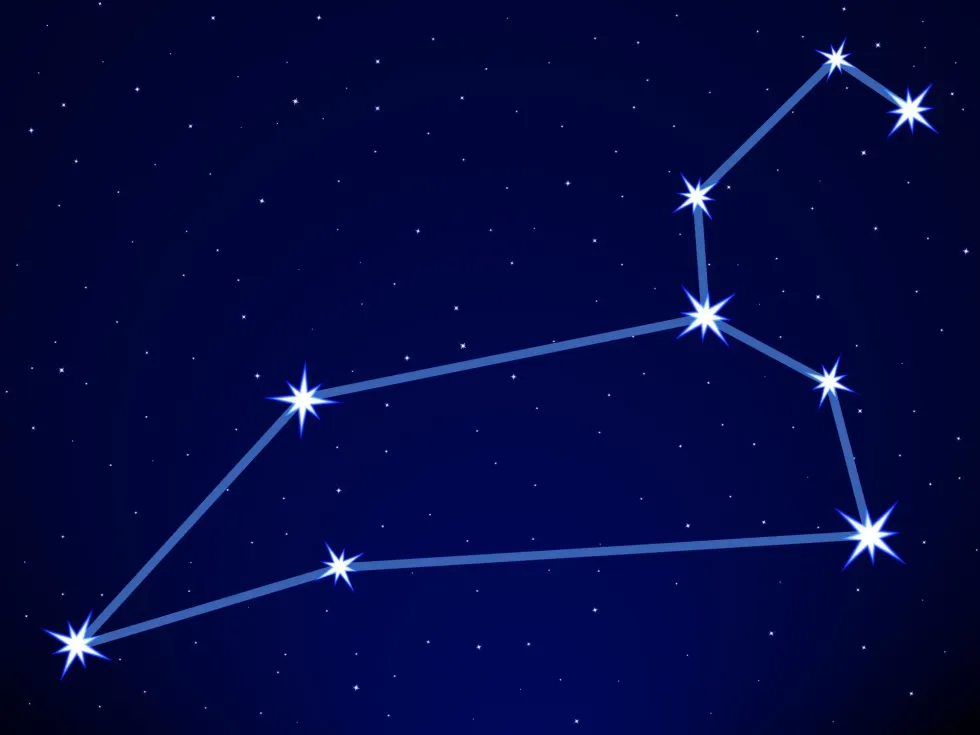The Lion Leo, also one of the 12 signs of the zodiac, is one of the brightest constellations in the night sky.
Highly visible from October to July, the constellation of Leo is located between the constellations Cancer and Virgo and can be observed in the Northern Hemisphere. This constellation is quite easy to find as the pointer stars of the Big Dipper which is very easy to find in the sky lead to the Leo constellation in the south.
This constellation is also in line with Polaris, also known as the North Star, which is fixed in the sky. Following Polaris south will lead towards the Big Dipper, and subsequently Leo the Lion.
The Leo constellation is made out of many stars, out of which 13 shine the brightest. These stars have been named and recognized by the International Astronomical Union, and many of them also act as primary stars for their own solar system set-ups.
A number of galaxy systems and space clouds can also be observed in this constellation, making it quite an interesting one to study! The constellation of Leo is also important in Greek mythology.
Size And Comparison
Leo the Lion is the 12 largest constellation in the sky out of the other 88 known constellations.
This constellation is quite large and occupies a space of 947 degrees squared in the night sky. It is located between the Cancer and Virgo constellations in the Zodiac belt.
It is surrounded by smaller constellations like Coma Berenices, Crater, Hydra, Lynx, Leo Minor, Ursa Major, and Sextans. Leo Minor, the 'smaller lion', lies north of Leo Major. It is much fainter than Leo Major and was not considered as a separate constellation until recently.
The constellation of Leo is one of the most recognizable constellations because it actually resembles a lion! It becomes highly visible around the spring equinox, which occurs in March, and is visible from October to July in the Northern Hemisphere.
This constellation is associated with the time period between 23 July-22 August, and people born during this time period are known to be born under the zodiac sign of Leo the Lion.
Other Characteristics Of The Constellation Of Leo
The Leo constellation is known for the yearly meteor showers which occur in its vicinity. Every year, a large number of shooting stars occur in a short period of time, which are caused by comets that orbit the Sun. The amazing thing is that these meteor showers happen on almost exactly the same dates every year!
The famous Roman poet Ovid named the constellation Hercules Leo after the great Greek hero who subdued and slayed the lion and Bacchus, named after the Greek god of wine who was associated with lions. The Leo triplet refers to a group of three small galaxies which is part of the constellation.
These are the Messier 65 (intermediate spiral galaxy), Messier 66 (intermediate spiral galaxy), and NGC 3628 (unbarred spiral galaxy) galaxies, all of which are located around 35 million light-years away.
The Leo ring, comprising a helium and hydrogen gas cloud, comes under the orbit of two dwarf galaxies and is located in the center of the Leo group of galaxies (M96 group).
Wolf 359, one of the closest stars to the Earth other than the Sun, is a red dwarf star that is located 7.78 light-years away and is part of the constellation Leo.
Regulus, which is the brightest star in the constellation of Leo, forms a star pattern called the Spring triangle with the stars Spica and Arcturus.
Five Messier galaxies, part of the Messier group of objects found by French astronomer Charles Messier are part of the Leo constellation. These are Messier 65, Messier 66, Messier 95, Messier 96 and Messier 105.
If you know where Leo is located in the sky, you will also be able to find Orion the Hunter. In the night sky, the constellation Leo is easy to spot as it appears to be chasing Orion and his dogs.
Look for the direction that the 'sickle' or lion's head is facing because you will see Orion running away! In between them lies the Canis Minor, or constellation of the little dog.
The Legend Of The Leo Constellation
The constellation Leo is actually named after the Nemean lion, a terrifying monster who is part of Greek mythology. As the legend goes, this vicious lion had extremely powerful golden fur which mortal weapons could not cut through.
Taking advantage of this, the lion terrorized the citizens of Greece, wreaking havoc everywhere it went.
He was known for taking women captive in his den, and keeping them as bait so that warriors would come and try to save them.
He would attack the warriors when they came to rescue the women, ambushing and killing them. Eventually, Hercules, who was sent to King Eurystheus to perform penance for killing his wife, Megara and children in a fit of rage set upon him by Zeus's wife Hera, was given the task of finding and eventually killing the lion.
Killing the Nemean lion was the first of 12 difficult tasks given to him by the king, which eventually came to be known as the 12 labors of Hercules.
When Hercules found the lion wandering the Cleonae, he fired arrows at it, trying to wound the lion from a distance.
However, he also found that neither his arrows nor any other weapons he tried to use against the lion were able to penetrate its skin. He tried to kill it with items made of bronze, silver, and even gold but all of them failed.
Finally, he was able to overpower the lion by shooting it in the mouth with his arrows, stunning it with his club, and then strangling the lion to death.
Once he killed the lion, he attempted to skin its valuable gold fur from its body with no luck.
As he sat helplessly, the war goddess Athena appeared to him and advised that he use one of the lion's sharp claws to take the pelt off. After successfully doing so, Hercules turned the pelt into a cloak, using its highly resistant properties as armor.
It is said that once Hercules released the lion from its misery, it made its way to the heavens and has been installed in the night sky, creating the constellation Leo.
This constellation is also one of the 12 signs of the Zodiac. The name Leo means 'lion' in Latin, with it being the short form of the name Leon or Leopold, which means 'brave' or 'lion-hearted'.
Major Leo Constellation Stars
The constellation Leo consists of a great number of bright stars, which were named by the Ancient Greeks using their alphabet.
The constellation itself is made of dozens of stars. The 13 brightest stars are Alterf, Sagarmatha, Zosma, Chertan, Dingolay, Algieba, Formosa, Denebola, Moriah, Regulus, Subra, and Rasalas. The names for these stars in the constellation have been approved by the International Astronomical Union.
The constellation can be identified by searching for a lion's head, or 'sickle', which starts the Regulus (Alpha Leonis) star. The Alpha Leonis, Latin for 'little king', is the brightest star in the constellation. This bright star is also known as the king star and stands for the Nemean lion.
It is followed by the stars Gamma Leonis (Algieba), meaning 'lion's mane', Zeta Leonis (Adhafera), Epsilon Leonis (Algenubi), meaning 'southern star' or 'yellow giant', Eta Leonis, and Mu Leonis (Rasalas), with the six stars making up the rest of the sickle in the shape of a backward question mark.
These signify the chest and shoulder of the lion, along with the head. The stars Mu Leonis and Epsilon Leonis along with Kappa Leonis and Lambda Leonis form the head of the lion.
Gamma Leonis (Algieba), Delta Leonis, Eta Leonis, and Theta Leonis form the neck and body of the lion.
The name, Gamma Leonis (Algieba), comes from 'Al Gieba', which means 'the forehead' in Arabic, as it makes up the forehead of the lion. It is a double star operating in a binary star system.
The lion's tail is comprises Delta Leonis and Beta Leonis.
Beta Leonis is also known as Denebola, which means 'little lion's tail', and makes up the tip of the lion's tail in the constellation. Most of the stars in the constellation host planets, and act as the primary star for them similar to how the Sun is the primary star of our solar system.









